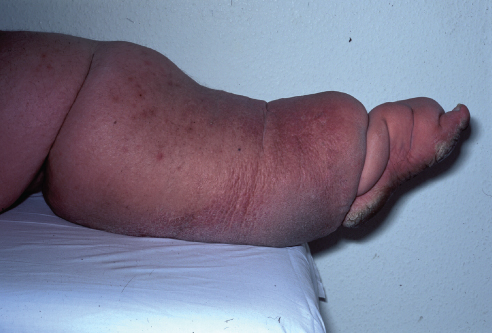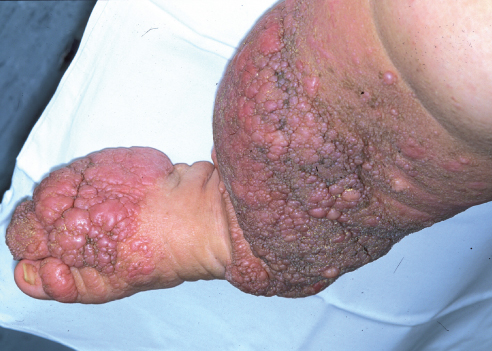Chapter 11
Lymphoedema
Vaughan L. Keeley and Ruth A. England
Royal Derby Hospital, UK
Introduction
Lymphoedema is a swelling of the tissues as a result of a failure of lymphatic drainage. When it first develops, the swelling is mainly due to the accumulation of fluid, but over time fibrosis occurs and adipose tissue is deposited. In the past, lymphoedema has been considered to be uncommon and untreatable. However, current thinking is rather different, as described here.
Lymphoedema/chronic oedema
All oedema arises from an imbalance of capillary filtration and lymphatic drainage (Box 11.1). Therefore, technically, all oedema has a lymphatic component.
For example, in venous disease, capillary filtration is increased as a result of increased venous pressure. This leads to an increase in lymphatic drainage to match it. When the transport capacity of the lymphatic system is exceeded, capillary filtration outstrips lymphatic drainage and oedema develops (high output failure of the lymphatics in a venous oedema). However, over time, the increased flow in the lymphatics declines, probably as a result of vessel damage, and a further failure of lymphatic drainage develops (lymphoedema).
In immobile patients, a chronic ‘dependency’ oedema of the lower limbs is often seen (armchair legs). This arises from a failure of the muscle pump in the legs to propel both blood and lymph in the veins and lymph vessels, respectively. Thus, venous pressure and therefore capillary filtration is increased and lymphatic flow is reduced, resulting in oedema.
In pure lymphoedema, lymphatic failure is of two types:
- Primary Lymphoedema. This is due to a genetic abnormality of the lymphatic system.
- Secondary Lymphoedema. This arises from an extrinsic process that damages a normal lymphatic system, e.g. surgery, trauma, radiotherapy or infection (cellulitis and filariasis).
In clinical practice, pure lymphoedema may be relatively uncommon, but many patients have chronic oedema that can have a lymphatic component. These patients suffer similar problems to those with pure lymphoedema. Thus, the umbrella term ‘chronic oedema’ is useful: both clinically to describe the range of conditions and in epidemiological studies looking at prevalence and aetiology.
Prevalence
The prevalence of oedema is not clear from the literature. ‘Chronic oedema’ has been defined as an oedema of greater than 3-month duration affecting any part of the body: limbs and mid-line structures, e.g. head and neck, trunk and genitalia. In a study carried out in Derby, UK, the prevalence was found to be 3.99 per 1000 population overall. Prevalence increased with age, rising to 10.31 per 1000 in those aged 65–74 years and 28.57 per 1000 in those >85 years. Clinical experience suggests that prevalence is increasing, both as the population ages and as obesity becomes more common.
In cancer treatment-related oedema, there is a wide range of incidences reported (Box 11.2). This is partly as a result of the difficulty in defining what constitutes a significant oedema. In addition, the length of follow-up affects the measured incidence as lymphoedema can develop many years after treatment, particularly following radiotherapy. Finally, changing treatment techniques (e.g. sentinel node biopsy) are likely to produce different patterns of lymphoedema, so older published literature may not reflect the current situation. Nevertheless, the general theme is that the more damage done to the lymphatic system during treatment, the more likely it is for the patient to develop lymphoedema.
Clinical features of chronic oedemas
The features of chronic oedemas depend on their aetiology. Chronic venous disease is described elsewhere (Chapter 15). This chapter focuses on the specific features of lymphoedema.
When lymphoedema first develops, it appears as a soft, pitting swelling that does not have any pathognomonic features. However, with time, a chronic inflammatory process causes fibrosis and adipose tissue accumulates in the subcutaneous tissues. Thus, the swelling becomes firmer and less easy to ‘pit’. At the same time, typical skin changes develop (Box 11.3; Figures 11.1 and 11.2). Patients with lymphoedema also experience a number of symptoms (Box 11.4). The impact of chronic lymphoedema on a patient’s quality of life is often underestimated by healthcare professionals. It can present a significant physical, psychological, social and financial burden.

Figure 11.1 Lymphoedema of the leg showing shape distortion and increased skin creases.

Figure 11.2 Severe papillomatosis in a lymphoedematous leg.

Full access? Get Clinical Tree


